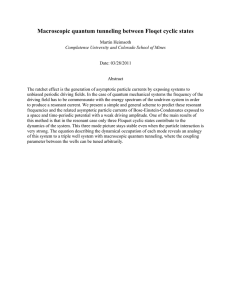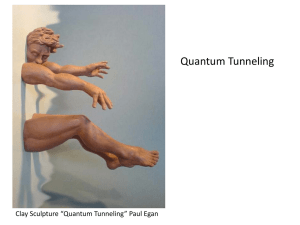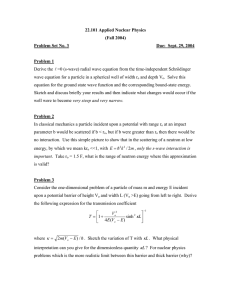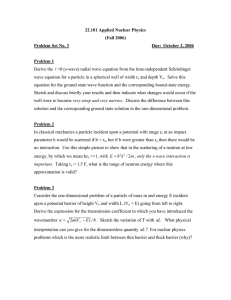Quantum Mechanical Tunneling
advertisement
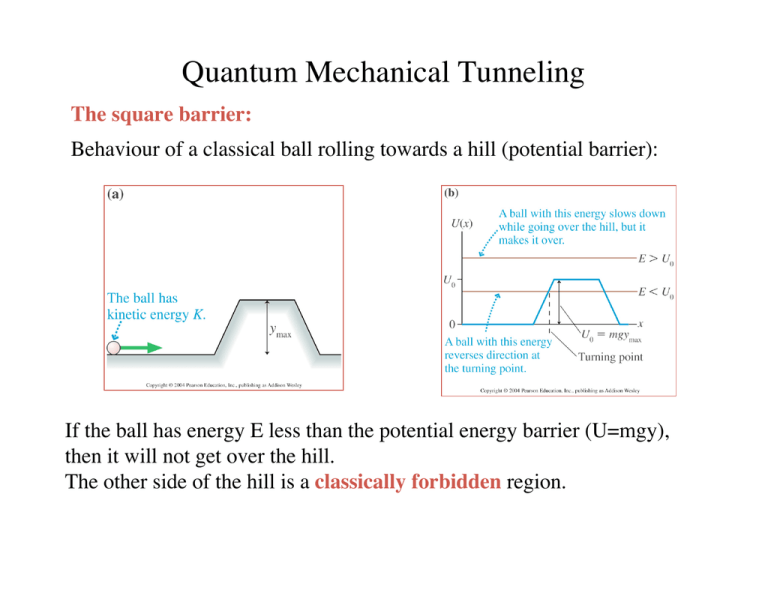
Quantum Mechanical Tunneling The square barrier: Behaviour of a classical ball rolling towards a hill (potential barrier): If the ball has energy E less than the potential energy barrier (U=mgy), then it will not get over the hill. The other side of the hill is a classically forbidden region. Quantum Mechanical Tunneling The square barrier: Behaviour of a quantum particle at a potential barrier Solving the TISE for the square barrier problem yields a peculiar result: If the quantum particle has energy E less than the potential energy barrier U, there is still a non-zero probability of finding the particle classically forbidden region ! This phenomenon is called tunneling. To see how this works let us solve the TISE… Quantum Mechanical Tunneling The square barrier: Behaviour of a quantum particle at a potential barrier To the left of the barrier (region I), U=0 Solutions are free particle plane waves: ! (x) = Ae + Be ikx "ikx , k= 2mE ! The first term is the incident wave moving to the right The second term is the reflected wave moving to the left. Reflection coefficient: R = !reflected 2 !incident 2 = B 2 A 2 Quantum Mechanical Tunneling The square barrier: Behaviour of a quantum particle at a potential barrier To the right of the barrier (region III), U=0. Solutions are free particle plane waves: 2mE ! ! (x) = Feikx , k = This is the transmitted wave moving to the right Transmission coefficient: T= !transmitted !incident 2 2 = F 2 A 2 T + R =1 Quantum Mechanical Tunneling The square barrier: Behaviour of a quantum particle at a potential barrier In the barrier region (region II), the TISE is !2 d 2 ! " (x) = (E ! U )" (x) 2 2m dx Solutions are ! (x) = Ce "# x #x + De != 2m(U " E) ! Quantum Mechanical Tunneling The square barrier: Behaviour of a quantum particle at a potential barrier At x=0, region I wave function = region II wave function: Aeikx + Be!ikx = Ce!" x + De" x A+ B=C+ D At x=L, region II wave function = region III wave function: Ce!" L + De" L = FeikL Quantum Mechanical Tunneling The square barrier: Behaviour of a quantum particle at a potential barrier At x=0, dϕ/dx in region I = dϕ/dx in region II: ikAeikx ! ikBe!ikx = !" Ce!" x + " De" x ikA ! ikB = !" C + " D At x=L, dϕ/dx in region II = dϕ/dx in region III : !" Ce!" L + " De" L = ikFeikL Quantum Mechanical Tunneling The square barrier: Behaviour of a quantum particle at a potential barrier Solving the 4 equations, we get T= 1 % " e( L + e!( L % 1 " U2 1+ $ ' 4 # E(U ! E) '& $# 2 & 2 For low energies and wide barriers, T ! e" # L For some energies, T=1, so the wave function is fully transmitted (transmission resonances). This occurs due to wave interference, so that the reflected wave function is completely suppressed. Quantum Mechanical Tunneling The step barrier: To the left of the barrier (region I), U=0. Solutions are free particle plane waves: ! (x) = Ae + Be ikx Case 1 Energy Ψ(x) "ikx , k= 2mE ! Case 2 Quantum Mechanical Tunneling The step barrier: Inside Step: U = Vo !2 d 2 ! " (x) = (E ! V0 )" (x) 2 2m dx Case 1 k2 = 2m(E ! V0 ) ! Case 2 Ψ(x) is oscillatory for E > Vo Ψ(x) is decaying for E < Vo Energy E > Vo Ψ(x) E < Vo Quantum Mechanical Tunneling The step barrier: ! k1 # k2 " R =$ % & k1 + k2 ' k1 = 2mE ! 2 T= k2 = 4k1k2 (k1 + k2 ) 2 2m(E ! V0 ) ! R(reflection) + T(transmission) = 1 Reflection occurs at a barrier (R ≠ 0), regardless if it is step-down or step-up. R depends on the wave vector difference (k1 - k2) (or energy difference), but not on which is larger. Classically, R = 0 for energy E larger than potential barrier (Vo). Quantum Mechanical Tunneling The step barrier: A free particle of mass m, wave number k1 , and energy E = 2Vo is traveling to the right. At x = 0, the potential jumps from zero to –Vo and remains at this value for positive x. Find the wavenumber k2 in the region x > 0 in terms of k1 and Vo. Find the reflection and transmission coefficients R and T. k1 = k2 = 2m V ! E ! = 4mVo ! ! 2m !Vo ! 2Vo 2m 3Vo 6mVo ! ! "k ! " k1 ! k2 % R =$ =$ 1 ' $# k + # k1 + k2 & 1 2 ( )= 2m 2Vo 2mE = ! ! 3 % 2 k1 2 = ( )= and or 3 k1 2 2 " !0.225 % ' =$ '& = 0.0102 3 ' 2.225 # 2 k1 & (1% reflected) T = 1! R = 1! 0.0102 = 0.99 (99% transmitted) Quantum Mechanical Tunneling Sketch the wave function ψ(x) corresponding to a particle with energy E in the potential well shown below. Explain how and why the wavelengths and amplitudes of ψ(x) are different in regions 1 and 2. V1 !(x) Region 1 Region 2 E V2 x1 x2 x ψ(x) oscillates inside the potential well because E > V(x), and decays exponentially outside the well because E < V(x). The frequency of ψ(x) is higher in Region 1 vs. Region 2 because the kinetic energy is higher [Ek = E - V(x)]. The amplitude of ψ(x) is lower in Region 1 because its higher Ek gives a higher velocity, and the particle therefore spends less time in that region. Quantum Mechanical Tunneling Sketch the wave function ψ(x) corresponding to a particle with energy E in the potential shown below. Explain how and why the wavelengths and amplitudes of ψ(x) are different in regions 1 and 3. Region 2 !(x) E Vo Region 1 Region 3 x ψ(x) oscillates in regions 1 and 3 because E > V(x), and decays exponentially in region 2 because E < V(x). Frequency of ψ(x) is higher in Region 1 vs. 3 because kinetic energy is higher there. Amplitude of ψ(x) in Regions 1 and 3 depends on the initial location of the wave packet. If we assume a bound particle in Region 1, then the amplitude is higher there and decays into Region 3 (case shown above). Quantum Mechanical Tunneling The scanning tunneling microscope: Scanning-tunneling microscopes allow us to see objects at the atomic level. • A small air gap between the probe and the sample acts as a potential barrier. • Energy of an electron is less than the energy of a free electron by an amount equal to the work function. • Electrons can tunnel through the barrier to create a current in the probe. • The current is highly sensitive to the thickness of the air gap. • As the probe is scanned across the sample, the surface structure is mapped by the change in the tunneling current. Quantum Mechanical Tunneling The scanning tunneling microscope: Scanning-tunneling microscopes allow us to see objects at the atomic level. • A small air gap between the probe and the sample acts as a potential barrier. • Energy of an electron is less than the energy of a free electron by an amount equal to the work function. • Electrons can tunnel through the barrier to create a current in the probe. • The current is highly sensitive to the thickness of the air gap. • As the probe is scanned across the sample, the surface structure is mapped by the change in the tunneling current. Carbon Monoxide on Platinum Iron on Copper www.almaden.ibm.com/vis/stm/ Quantum Mechanical Tunneling Decay of radioactive elements: Emission of α particles (helium nucleii) in the decay of radioactive elements is an example of tunneling • α particles are confined in the nucleus modeled as a square well • α particles can eventually tunnel through the Coulomb potential barrier. • Tunneling rate is very sensitive to small changes in energy, accounting for the wide range of decay times: 8 E0 ZR ! 4" Z r0 E T =e , r0 # 7.25 fm, E0 = 0.0993MeV Quantum Mechanical Tunneling Decay of radioactive elements: Emission of α particles (helium nucleii) in the decay of radioactive elements is an example of tunneling • Transmission probability: 8 E0 ZR ! 4" Z r0 E T =e , r0 # 7.25 fm, E0 = 0.0993MeV • Transmission rate λ = frequency of collisions with the barrier x T ! = fT " 10 21 e • Half life: 8 E0 ZR # 4$ Z r0 E t1/2 , 0.693 = ! Quantum Mechanical Tunneling Other applications of quantum mechanical tunneling: • Tunneling diodes (used in digital chips in computers) • Explanation of ammonia inversion (see text) • Theory of black hole decay • …..
